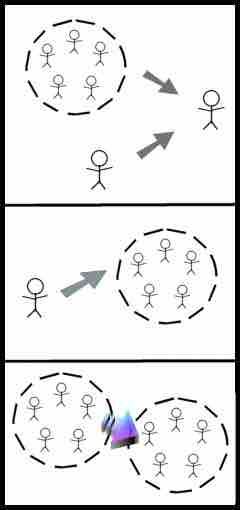In the social sciences a social group is defined as two or more humans who interact with one another, share similar characteristics and collectively have a sense of unity. Social groups come in a myriad of sizes and varieties. Groups can also be categorized in various ways, one of which is according to the number of people present within the group. This makes sense if the size of the group has consequences for the way group members relate with each other.
Individual behavior deviates substantially in a group setting; therefore, it is difficult to determine group behavior by looking solely at the individuals that comprise the group. Group attitudes and behavior depend upon several variables: size, structure, the purpose that the group serves, group development and various influences upon a group. Group dynamics refers to a system of behaviors and psychological processes occurring within a social group or between social groups. Individual behavior has been shown to be influenced by the presence of others. For example, an individual's performance at work or the individual's decision-making processes (as in the term "groupthink").
Effects of Group Size
Size (the number of people involved) is an important characteristic of groups, organizations and communities in which social behavior occurs .
Dyads and triads are the smallest social groups. Social interaction in a dyad is typically more intense than in larger groups because neither member shares the other's attention with anyone else. A triad is more stable than a dyad because one member can act as a mediator should the relationship between the other two become strained.
As an organization or community grows in size it is apt to experience tipping points where the way it operates needs to change. The complexity of large groupings is partly because they are made up of interrelated subgroups . As the size of a group increases, the need for more organization or leadership also often becomes more obvious.
Crowds and Large Groups
This large group may share some traits (such as enjoyment of the concert that the crowd just witnessed), but likely vary in many other traits. Large groups introduce diversity of attitudes and behaviors.
German sociologist Georg Simmel argued that as the group becomes greater, the individual becomes separated and grows more alone, isolated and segmented. Simmel's view was somewhat ambiguous with respect to group size. On one hand, he believed that the bigger the group the better for the individual. In a larger group it would be harder to exert control on an individual, but there is a possibility of the individual becoming distant and impersonal.

Studying Group Attitudes and Behaviors
Sociologists study interactions within groups, and between both groups and individuals.